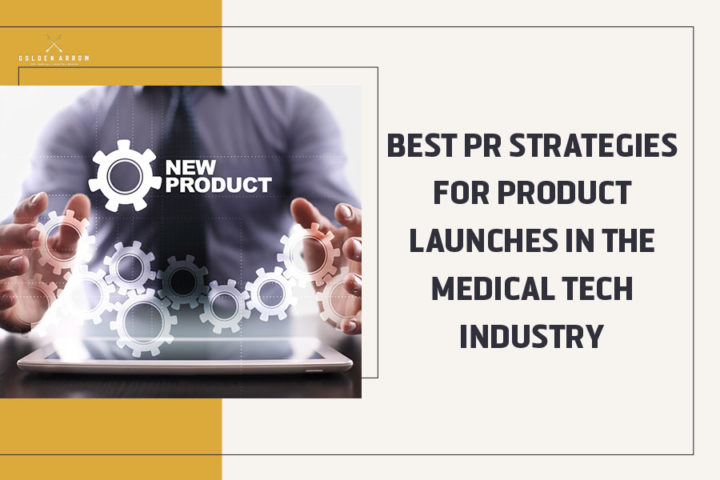The main challenges that a PR team faces when launching a medical product involve planning, developing a communication strategy, implementation, and assessment. However, the biggest one of any product launch is positioning a product by offering compelling information to set the brand apart. Consequently, brands always look for the best PR strategies for product launches in the medical industry.
With years of experience in the field, we will share some of our proven PR approaches for introducing technology in healthcare. This article will disclose practices that can help create valuable content and teach you how to create a quality PR campaign to reach your business goals.

Best PR Strategies for Product Launches in the Medical Tech Industry
The success of any medical product heavily relies on its debut. PR in the healthcare industry strategically promotes the brand as well as creates a tailored story and image of the product presented to the target audience.
The overall purpose of medical PR is to showcase the product through a specific lens that offers customers the facts and characteristics concisely and digestible. For this purpose, we will discuss key PR strategies for successfully launching medical tech products in greater detail.
Preparing for a successful product launch
Planning and preparation are essential; we believe they are important in ensuring a successful product launch. Initial preparations usually begin six to 12 months before the launch.
During this period, we will focus on planning what the PR campaign should look like. This process revolves around choosing channels and marketing tactics that we will use to achieve our goals and reach the KPIs. Setting up a budget and establishing clear expectations is central during this stage.
Market research and understanding the audience
Many companies fail to reach their target audience due to improper marketing efforts. For us, this process begins with a closer look at the buyer’s persona.
Our primary concern during this process is understanding how to reach the target audience. This initial step helps map the customer journey and allows us to guide them more easily through the marketing funnel.
Another vital component of the product launch is market assessment. Performing a current market analysis offers insight into the medical market landscape. It helps us identify potential market gaps and competition.
Also, many like to introduce a test market before the launch to examine the terrain. This is usually done by running a sample promotional campaign in collaboration with a trusted distributor.
In the medical tech industry, securing an FDA (Food and Drug Administration) approval before the launch is of key significance. The FDA often has an unpredictable timeline, and we try to eliminate unpredictability when planning a product launch. This is why having the product documentation helps the project team operate more smoothly while avoiding unnecessary surprises.
Crafting a compelling narrative for the product
Medical devices are generally difficult to market if you lack prior experience in the healthcare industry. That is because tech innovations are constantly surging the market. So, a competitor can easily overshadow the product when the story is not being told effectively.
For a story to receive recognition, it needs to be newsworthy. While the main goal of PR in the health industry might be to launch the product, the brand needs to find a way to connect with the audience. This is why when creating the content, the aim shouldn’t be to sell the product; instead, it must educate the audience and speak to their values.
The narrative should always reflect brand values and get the main point across, which is “how the product can help save lives”. We find that one of the best PR strategies is illustrating how the product operates using technology. This gives the audience a unique angle and adds much more value than just explaining the product’s qualities.
Building relationships with key industry influencers and stakeholders
One of the most effective ways to reach a target audience is by using influencers as part of the PR strategy. Strong media connections can make it easier for brands to reach potential customers and establish greater media outreach and overall integrity.
However, it’s important to build a network of professionals who are a part of the medical industry or are somehow connected to the healthcare field. This can help place the product strategically in the market.
We also see immense value in gaining endorsement from a regulatory body. This builds credibility in the eyes of the general public and confirms your expertise to clinicians, investors, and other regulators.
Tailoring PR strategies for the medical tech industry
Our medical device go-to-market strategy relies on building credibility and trustworthiness. And many different elements come into place to make this possible.
Since the medical field is one that potential clients rigorously analyze, it’s important to establish the brand as an expert and a market leader. The healthcare sector has become increasingly competitive due to existing brands constantly expanding their offerings and new companies and technologies entering the market.
Hence, we believe the PR strategy has to focus on differentiating the brands from the others and building trust. Some of the best ways to achieve this is by showcasing proof in the form of medical studies and securing publication in the right outlets.
Mindful communication
When running a medical PR campaign, the team must be familiar with all the regulatory principles and consider the ethical and sentimental qualities involved. This requires a deep understanding of the terminology and extra precautions when crafting the messages for the media.
So, much of the success of the PR campaign relies on the team’s ability to deal with complex and sensitive issues professionally. Medical PR is a niche that requires both knowledge and experience. The PR company managing the campaign needs to have industry connections and a solid grasp of current trends and future innovations.
Incorporating visuals for complex technologies
Visual representations such as infographics are among the best ways to aid a medical PR strategy. The technology involved is often difficult to present in words.
However, using visual elements can ease communication on more complex subjects. Including video content on your web page and sharing it through social media will help potential clients understand how the product can be used.
Utilizing digital platforms and content marketing
The best approach to digital PR is to be omnipresent. This doesn’t mean overstimulating or haunting the audience should be a primary concern. Instead, the brand should be easily accessible. Using social media tools to boost awareness about your brand and products is an effective way to remain close to the target audience.
By making your brand available on social media, you also increase your chances of reaching new clients or patients. This is a win-win situation, as those interested can easily establish contact while the medical company gains exposure.
We know that launching products always sparks the interest of the public. Potential customers always have concerns and questions about the product and don’t hesitate to reach out. Since customer experience is essential to product success, brands that offer human support and automation usually get the best results.
Launching a dedicated website or landing page for the product
While being active on social media is important for both PR and marketing purposes, having a dedicated website is another factor that adds credibility. Designing a dedicated landing page for the product will help the brand maintain a more professional look. However, this can also help track the campaign’s KPIs (Key Performance Indicators).
Partnering with key opinion leaders (KOLs) and experts
Partnering with influencers can assist brands in reaching a broader audience. Yet, when it comes to establishing a company as an expert in the field, endorsements from opinion leaders hold greater significance.
The KOL collaboration is usually based on an interaction model. Meaning, co-hosting a live Q&A session, a webinar, or a similar event. The KOL partnership can also be done to co-produce content such as tutorials, blog posts, or any other type of content that would interest the audience.
While the KOL collaboration mainly aims to back up the credibility of your PR campaign, it should also educate the audience. This means the content for this campaign should offer insight into the latest trends and personal experiences while promoting brand messages.
Moreover, the KOL collaboration creates space for a lot of opportunities. It’s worth noting that this partnership is meant to last rather than be just a single-time appearance. When done correctly, we think it may help a brand gain a significant competitive advantage and much recognition.

Managing crisis and contingency plans
Healthcare PR crises can damage not only the course of the PR campaign but also have a lasting effect on the company’s reputation. As mentioned earlier, creating trust between a medical company and its clients is essential, and a PR crisis threatens this trust.
This jeopardy of trust can damage key relationships with partners and stakeholders and potentially undermine the value of the business. This is why the PR company has to be skilled at managing potential crises.
Anticipating potential challenges and risks
In the medical field, the issue is not whether or not a PR crisis might emerge, but the better question is when it will emerge. In reality, the PR campaign might not generate any potentially damaging feedback. It is always best to be prepared and anticipate what can cause it.
Establishing protocols for handling negative feedback or issues
Some of the most common problems in healthcare arise due to employee actions, bad press, or social media backlash. Therefore, a healthcare communication plan is preferable in case of a crisis.
This plan is created by taking the time to assess key risk scenarios. Acting without a plan and responding intuitively when a crisis emerges can lead to a difficult situation or disaster.
So, every disaster plan must contain crisis management coordinators and a spokesperson. Each team member has a role and knows how to handle social media monitoring and posting. It is also a good idea to prepare the company’s employees to respond in times of crisis if the press approaches them or becomes engaged in the matter.
Maintaining transparency and swift communication
One of the key principles in healthcare crisis management is to avoid responding emotionally and keep in mind that the storm will pass. The circumstances can often be absurd, and the tensions built up might lead some to lash out, but this may only worsen a situation.
However, this doesn’t mean not responding at all will be a suitable solution. While it is important not to rush the response, the company must offer one.
Accepting full ownership of the issue and apologizing is a tried-out method in healthcare PR management. A crisis must be managed with integrity; this means it should be truthful and factual to eliminate or reduce further problems.
Measuring success and ROI
One of the reasons why digital PR can be more efficient than traditional PR practices is because it allows companies to track their success or lack thereof more easily. Those who follow the guidelines for best PR strategies for product launches in the medical tech industry will have clear goals set during the planning stage.
Furthermore, one of the most critical KPIs of every campaign is revenue. Inspecting sales can offer insight into product performance. However, evaluating what portion of the market share belongs to your product is also a good practice, as other similar products are on the market.
At the same time, the medical device is probably competing against other leaders in the market. So, measuring the competitive win rate is another aspect that determines a successful launch.
Companies can also assess social media engagement and inspect client feedback through testimonials and review pages to better understand audience response. Yet, tracking their engagement is also useful.
Incorporating feedback loops for continuous improvement
Feedback doesn’t have to rely on metrics and ROI only. It can also be collected from marketers, sales personnel, executives, product managers, etc. These can be a form of cultural feedback and concern the level of engagement before, during, and after the product launch.
Additionally, seeking feedback from external sources, such as customers, is another step toward future improvement. This could be constructive notes about the product design, thoughts on launch elements, etc.

Conclusion
A medical PR company must be well-versed in several segments to deliver a successful product launch. The PR teams must consider the complexities involved when planning a product launch.
The medical field is a place of innovation but also has a sentimental element involved. This is why the best PR strategies for product launches in the medical tech industry revolve around detailed planning and research.
To recap, credibility is one of the main aspects a medical company has to establish to position itself as a market leader. This is usually achieved by involving expert bodies or individuals in the PR campaign. To gain the audience’s trust, most PR companies try to cover all the fields by reaching out to the audience on several fronts.
Also, some of the most helpful tactics include running a social media campaign creating a website, and a landing page for the product. Overall, the efforts of the PR team are focused on promoting the product’s characteristics and uniqueness while maintaining brand values.


